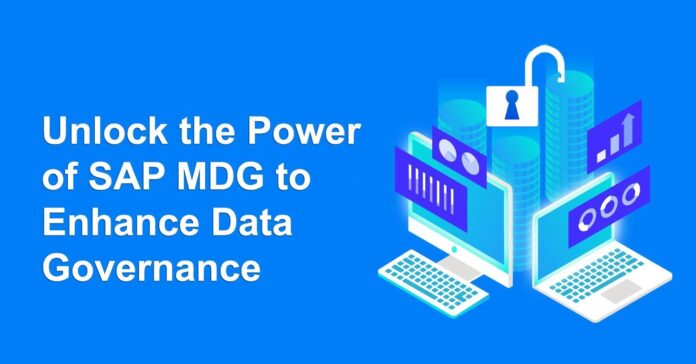In today’s fast-paced business world, data has become the lifeblood of organisations. However, managing this ever-growing volume of data can be a nightmare without proper tools and governance. This is where SAP Master Data Governance (MDG) comes into play.
SAP MDG is a powerful tool that enables organisations to efficiently manage their master data across different systems and processes while ensuring compliance with regulatory requirements. In this article, we will explore how SAP MDG can help you unlock the power of your organisation’s data by enhancing your data governance practices. We’ll delve into its features, benefits, and real-world use cases to give you an in-depth understanding of this technology and how it can transform the way your organisation manages its master data.
What is SAP MDG?
A technology called SAP Master Data Governance (MDG) aids enterprises in efficiently governing their master data. It provides a centralised platform to manage, validate, and distribute master data across various systems. SAP MDG offers end-to-end data management capabilities, including data modelling, governance workflows, data quality management, and integration with other SAP and non-SAP systems. With SAP MDG, organisations can ensure the accuracy and consistency of their critical business information.
One of the key benefits of using SAP MDG is improved compliance with regulations such as GDPR or SOX. The solution allows companies to set up policies that ensure data privacy rules are respected and enforced throughout the organisation. Furthermore, by providing a single source of truth for master data records like customers or products, it helps reduce errors caused by duplicate or incomplete information. This leads to better decision-making processes based on reliable insights.
Overall, implementing SAP MDG can help organisations streamline their operations while reducing costs associated with manual maintenance of master data records in multiple systems. By unlocking the power of this solution through effective governance practices tailored to specific business needs and requirements, companies can achieve significant improvements in their overall performance metrics related to productivity, efficiency as well as customer satisfaction levels.
Benefits of using SAP MDG
SAP Master Data Governance (MDG) is a powerful tool that helps organisations manage their data governance processes more effectively. By using SAP MDG, companies can ensure that their master data is accurate, complete and consistent across all systems and departments. This can help improve operational efficiency, reduce errors and increase productivity.
One of the key benefits of using SAP MDG is improved data quality. The system provides a centralised platform for managing master data, which allows for better collaboration and consistency across different teams and departments. It also offers robust validation rules to help ensure that data entered into the system meets specific criteria.
Another advantage of SAP MDG is increased visibility into business processes. The system enables users to track changes made to master data over time, which can be invaluable in identifying trends or potential issues before they become major problems. Additionally, it enables faster decision-making by providing real-time access to critical information.
Overall, SAP MDG provides a comprehensive solution for managing master data governance processes within an organisation. By leveraging this powerful toolset, companies can improve their operational efficiency while reducing risks associated with inaccurate or incomplete data.
How it enhances data governance and quality.
Data governance and quality are crucial elements in any organisation that deals with large amounts of data. With the help of SAP MDG, companies can streamline their data governance processes and ensure high-quality data. SAP MDG provides a centralised platform for managing all master data domains, including customer, vendor, product, and financials.
By implementing SAP MDG, organisations can establish clear ownership of master data and define roles and responsibilities for maintaining it. This reduces the risk of errors and duplicates in the system. Additionally, SAP MDG enables automated workflows for requesting changes to master data records. This ensures that all modifications go through a standardised approval process before they are applied to the system.
Furthermore, SAP MDG offers comprehensive monitoring tools that enable organisations to track changes made to their master data over time. This helps identify patterns and trends in data quality issues so that corrective measures can be taken proactively. By enhancing their data governance processes with SAP MDG, companies can achieve higher operational efficiency, reduce risks associated with poor quality or inaccurate information, and make better-informed decisions based on trustworthy data.
Steps involved in implementing SAP MDG.
The implementation of SAP Master Data Governance (MDG) involves several key steps that are essential for its successful deployment. Firstly, it is important to identify the organisational requirements and objectives for implementing SAP MDG. Once these have been established, a detailed analysis of the current data governance structure must be conducted to determine any gaps or inefficiencies in the system.
The next step is to configure and customise the SAP MDG system based on the organisation’s specific needs and requirements. This includes setting up workflows, business rules, data models, hierarchies, and other relevant parameters. The data migration process must also be carefully planned and executed to ensure that all relevant master data is accurately transferred into SAP MDG from legacy systems.
Finally, thorough testing and training must be conducted before going live with SAP MDG. This will help ensure that all users are familiar with the system’s functionalities and can use it effectively for their respective roles. Ongoing support and maintenance should also be provided after implementation to ensure continuous improvement in data governance practices within the organisation.
Real-life examples of successful implementation.
One real-life example of successful implementation of SAP MDG for Data Governance is from a leading consumer packaged goods company. They were struggling with data inconsistencies across their global operations, which was causing significant delays in product launches and supply chain management. With the help of SAP MDG, they were able to establish a centralised data governance framework that ensured the accuracy and consistency of all critical data elements. As a result, they experienced improved operational efficiency, reduced costs, and faster time-to-market for new products.
Another example comes from a healthcare organisation that implemented SAP MDG to manage patient data across multiple systems. They had been struggling with duplicate records and incomplete information, which was affecting patient care and billing accuracy. By leveraging the capabilities of SAP MDG, they were able to standardise data fields across systems and establish workflows for managing updates and changes to patient records in real-time. This resulted in better patient outcomes and increased revenue due to more accurate billing practices.
Conclusion
In conclusion, SAP MDG provides a comprehensive solution for data governance within an organisation. By ensuring that all the data is accurate, complete, and consistent across different systems, businesses can make informed decisions confidently. The tool’s ability to automate data quality checks and workflows helps in maintaining the integrity of the data throughout its lifecycle.
Moreover, SAP MDGs flexibility enables it to be easily integrated into existing IT infrastructures and customised according to a company’s specific needs. This means that businesses can leverage the power of SAP MDG without disrupting their current processes. Additionally, with its user-friendly interface and intuitive design, employees can quickly adapt to using the tool with minimal training.
Overall, investing in SAP MDG is essential for any company looking to enhance their data governance practices. By centralising master data management activities through this platform, organisations can improve operational efficiency while reducing errors and inconsistencies in their critical business information.
Author Bio:
Pooja Bavireddy is a tech-savvy worker working as a Research Analyst . She is passionate about researching various technologies ,startups, and dreams big to accomplish varying goals.She is an expert in presenting information on market-leading technologies such as Pega, VMWare, SAP IBP, Webmethods, SCCM, SAP MDG, SAP FICO, Denodo and others.















